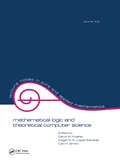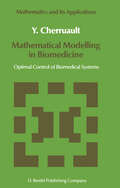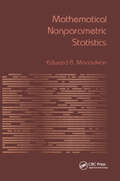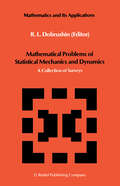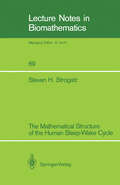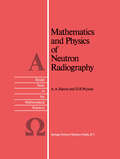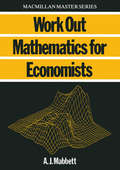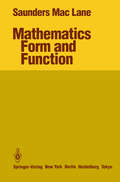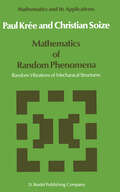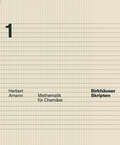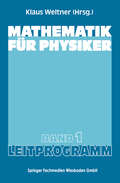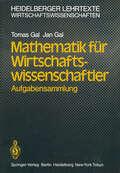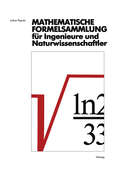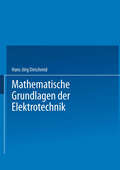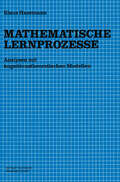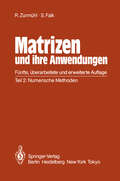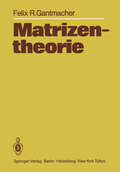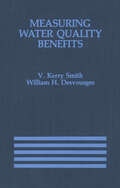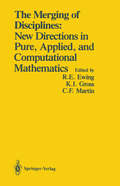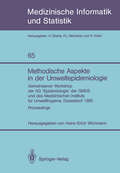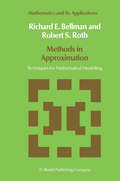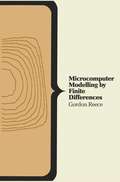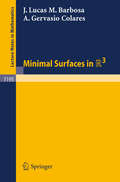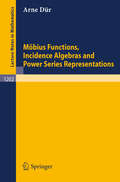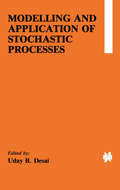- Table View
- List View
Mathematical Logic and Theoretical Computer Science
by David KuekerMathematical Logic and Theoretical Computer Science covers various topics ranging from recursion theory to Zariski topoi. Leading international authorities discuss selected topics in a number of areas, including denotational semanitcs, reccuriosn theoretic aspects fo computer science, model theory and algebra, Automath and automated reasoning, stability theory, topoi and mathematics, and topoi and logic.The most up-to-date review available in its field, Mathematical Logic and Theoretical Computer Science will be of interest to mathematical logicians, computer scientists, algebraists, algebraic geometers, differential geometers, differential topologists, and graduate students in mathematics and computer science.
Mathematical Modelling in Biomedicine: Optimal Control of Biomedical Systems (Mathematics and Its Applications #23)
by Y. CherruaultApproach your problems from the right It isn't that they can't see the solution. It end and begin with the answers. Then is that they can't see the problem. one day, perhaps you will find the final question. G.K. Chesterton. The Scandal of Father Brown 'The point of a Pin'. 'The Hermit Clad in Crane Feathers' in R. van Gulik's The Chinese Maze Murders. Growing specialization and diversification have brought a host of monographs and textbooks on increasingly specialized topics. However, the "tree" of knowledge of mathematics and related fields does not grow only by putting forth new branches. It also happens, quite often in fact, that branches which were thought to be completely disparate are suddenly seen to be related. Further, the kind and level of sophistication of mathematics applied in various sciences has changed drastically in recent years: measure theory is used (non-trivially) in regional and theoretical economics; algebraic geometry interacts with physics; the Minkowsky lemma, cod ing theory and the structure of water meet one another in packing and covering theory; quantum fields, crystal defects and mathematical pro gramming profit from homotopy theory; Lie algebras are relevant to filtering; and prediction and electrical engineering can use Stein spaces.
Mathematical Nonparametric Statistics
by Edward B. ManoukianFirst published in 1986. Primarily a reference text, Mathematical Nonparametric Statistics provides mathematicians and students with a systematic mathematical analysis and the fine points of nonparametrical statistical procedures and models used in practice. Divided into five sections and beginning with an extensive chapter on the fundamentals of mathematical statistical methods, its coverage of such topics as the Jackknife method, the Kolmogorov-Smirnov statistic, Box's method and the ch-squared test of fit is rigorous. Written for audiences with differing backgounds in mathematics, the book is of special use to those in the management sciences, industrial engineering, psychology and economics, as well as mathematics.
Mathematical Problems of Statistical Mechanics and Dyanamics: A Collection of Surveys (Mathematics and its Applications #6)
by R. L. DobrushinApproach your problems from the It isn't that they can't see the solution. right end and begin with the answers. It is that they can't see the problem. Then one day, perhaps you will find the final question. G. K. Chesterton. The Scandal of Father Brown 'The point of a Pin'. 'The Hermit Clad in Crane Feathers' in R. van Gulik's The Chinese Maze Murders. Growing specialization and diversification have brought a host of monographs and textbooks on increasingly specialized topics. However, the 'tree' of knowledge of mathematics and related fields does not grow only by putting forth new branches. It also happens, quite often in fact, that branches which were thought to be completely disparate are suddenly seen to be related. Further, the kind and level of sophistication of mathematics applied in various sciences has changed drastically in recent years: measure theory is used (non trivially) in regional and theoretical economics; algebraic geometry interacts with physics; the Minkowsky lemma, coding theory and the structure of water meet one another in packing and covering theory; quantum fields, crystal defects and mathematical programming profit from homotopy theory; Lie algebras are relevant to filtering; and prediction and electrical engineering can use Stein spaces. And in addition to this there are such new emerging subdisciplines as 'experimental mathematics', 'CFD', 'completely integrable systems', 'chaos, synergetics and large-scale order', which are almost impossible to fit into the existing classification schemes. They draw upon widely different sections of mathematics.
The Mathematical Structure of the Human Sleep-Wake Cycle (Lecture Notes in Biomathematics #69)
by Steven H. StrogatzOver the past three years I have grown accustomed to the puzzled look which appears on people's faces when they hear that I am a mathematician who studies sleep. They wonder, but are usually too polite to ask, what does mathematics have to do with sleep? Instead they ask the questions that fascinate us all: Why do we have to sleep? How much sleep do we really need? Why do we dream? These questions usually spark a lively discussion leading to the exchange of anecdotes, last night's dreams, and other personal information. But they are questions about the func tion of sleep and, interesting as they are, I shall have little more to say about them here. The questions that have concerned me deal instead with the timing of sleep. For those of us on a regular schedule, questions of timing may seem vacuous. We go to bed at night and get up in the morning, going through a cycle of sleeping and waking every 24 hours. Yet to a large extent, the cycle is imposed by the world around us.
Mathematics and Physics of Neutron Radiography (Reidel Texts in the Mathematical Sciences #1)
by A.A. Harms D.R. WymanNeutron radiography has in recent years emerged as a useful and complementary technology for radiation diagnosis. It is now routinely used in industrial quality assurance and in support of selected research and developmental activities. Conferences are held on the subject, pertinent handbooks exist, and technical papers appear regularly reporting on new developments. While neutron radiography has indeed passed through the transition from a scientific curiosity to technological relevance, it is a sign of its continuing dynamic evolution that little material has appeared which provides an integrated mathematical and physical analysis of the subject possessing both an instructional as well as reference function. It is our hope that this monograph will fill this need. The distinctiveness of neutron radiography rests on the unique interactions between neutrons and nuclei. This leads to some special relationships between the material and geometrical properties of an object and the neutron radiographic image. The evolution of a technical discipline demands that specific conceptual constructs be developed and their mathematical representations examined and compared with controlled experiments. Experience has convinced us that a particular and substantial body of knowledge has accumulated endowing neutron radiography with the essential foundations of a unique mathematical and physical science. Our scientific and professional involvement in neutron radiography began some 15 years ago when the senior author (A.A.H.) found himself with convenient access to the McMaster University Nuclear Reactor and research support from the Government of Canada.
Mathematics of Random Phenomena: Random Vibrations of Mechanical Structures (Mathematics and Its Applications #32)
by P. Krée C. SoizeApproach your problems from the right end It isn't that they can't see the solution. It is and begin with the answers. Then one day, that they can't see the problem. perhaps you will find the final question. G. K. Chesterton. The Scandal of Father 'The Hermit Clad in Crane Feathers' in R. Brown 'The point of a Pin'. van Gulik's The Chinese Maze Murders. Growing specialization and diversification have brought a host of monographs and textbooks on increasingly specialized topics. However, the "tree" of knowledge of mathematics and related fields does not grow only by putting forth new branches. It also happens, quite often in fact, that branches which were thought to be completely disparate are suddenly seen to be related. Further, the kind and level of sophistication of mathematics applied in various sciences has changed drastically in recent years: measure theory is used (non-trivially) in regional and theoretical economics; algebraic geometry interacts with physics; the Minkowsky lemma, coding theory and the structure of water meet one another in packing and covering theory; quantum fields, crystal defects and mathematical programming profit from homotopy theory; Lie algebras are relevant to filtering; and prediction and electrical engineering can use Stein spaces. And in addition to this there are such new emerging subdisciplines as "experimental mathematics", "CFD", "completely integrable systems", "chaos, synergetics and large-scale order", which are almost impossible to fit into the existing classification schemes.
Mathematik für Physiker: Basiswissen für das Grundstudium der Experimentalphysik (Lehrbuch Informatik)
by Klaus WeltnerStatt eines Vorwortes oder einer Einleitung sollen diesem Band nur kurze Vorbemerkungen vorangestellt werden. Das vorliegende Buch enthält die integrierenden Leit programme für die ersten fünf Kapitel des Lehrbuches "Die Mathematik des Physikers - Basis für das Grund studium der Experimentalphysik", Band 1. Die Leit programme können nur im Zusammenhang mit dem genannten Lehrbuch benutzt werden. Die Leitprogramme sind eine ausführliche Studienanleitung. Das Konzept, der Aufbau und die Ziele dieser Studienanleitung sind in der Ein leitung des Lehrbuches ausführlich beschrieben. Es wäre Papierverschwendung, diese Gedanken hier zu wieder holen. Sie können auf Seite 16 des ersten Bandes des Lehrbuches nachgelesen werden. Nur eine kurze Bemerkung zum Gebrauch dieses Buches: Die Anordnung des Buches unterscheidet sich von der Anordnung üblicher Bücher. Es ist ein "verzweigendes Buch". Das bedeutet, beim Durcharbeiten wird nicht jeder Leser jede Seite lesen müssen. Je nach Lern fortschritt und Lernschwierigkeiten werden individuelle Arbeitsanweisungen und Hilfen gegeben. Wer in diesem Buch hier den Beginn des Leitprogramms für ein Kapitel des Lehrbuches sucht, orientiert sich am Inhaltsverzeichnis und der Seitenzahl oben auf der Mitte der Seiten. Innerhalb des Leitprogrammes sind die einzelnen Lehr schritte fortlaufend in jedem Kapitel neu durchnumeriert. Ein Lehrschritt überdeckt jeweils eine halbe Seite. Die Nummern der Lehrschritte stehen auf dem rechten Rand.
Mathematik für Wirtschaftswissenschaftler: Aufgabensammlung (Heidelberger Lehrtexte Wirtschaftswissenschaften)
by Tomas Gal Jan GalMathematische Formelsammlung für Ingenieure und Naturwissenschaftler: Mit zahlreichen Abbildungen und Rechenbeispielen und einer ausführlichen Integraltafel
by Lothar PapulaVI Eine Bitte des Autors Für Hinweise und Anregungen - insbesondere auch aus dem Kreis der Studenten - bin ich stets dankbar. Ein Wort des Dankes . . . an die Mitarbeiter des Vieweg-Verlages für die hervorragende Zusammenarbeit während der Entstehung und Drucklegung dieses Werkes, . . . an meine Rüsselsheimer Studenten (insbesondere aus dem Fachbereich Maschinenbau) für wertvolle Diskussionsbeiträge zur Gestaltung dieser Formelsammlung. Lothar Papula Wiesbaden, Juni 1986 VII Inhaltsverzeichnis I Allgemeine Grundlagen aus Algebra, Arithmetik und Geometrie . . . . . . . . 1 Grundlegende Begriffe über Mengen . . . . . . . . . . . . . . . . . . . . . . . . . . . . . . . . . . . . 1. 1 Definition und Darstellung einer Menge . . . . . . . . . . . . . . . . . . . . . . . . . . . 1 1. 2 Mengenoperationen . . . . . . . . . . . . . . . . . . . . . . . . . . . . . . . . . . . . . . . . . . . 2 1. 3 Spezielle Zahlenmengen . . . . . . . . . . . . . . . . . . . . . . . . . . . . . . . . . . . . . . . 2 2 Rechnen mit reellen Zahlen. . . . . . . . . . . . . . . . . . . . . . . . . . . . . . . . . . . . . . . . . . . 3 2. 1 Reelle Zahlen und ihre Eigenschaften . . . . . . . . . . . . . . . . . . . . . . . . . . . . . 3 2. 1. 1 Rationale, irrationale und reelle Zahlen . . . . . . . . . . . . . . . . . . . . . 3 2. 1. 2 Rundungsregeln . . . . . . . . . . . . . . . . . . . . . . . . . . . . . . . . . . . . . . . 3 2. 1. 3 Darstellung der reellen Zahlen auf der Zahlengerade . . . . . . . . . . . 4 2. 1. 4 Grundrechenarten. . . . . . . . . . . . . . . . . . . . . . . . . . . . . . . . . . . . . 4 2. 2 Intervalle. . . . . . . . . . . . . . . . . . . . . . . . . . . . . . . . . . . . . . . . . . . . . . . . . . . 5 2. 3 Bruchrechnung. . . . . . . . . . . . . . . . . . . . . . . . . . . . . . . . . . . . . . . . . . . . . . 5 2. 4 Potenzen und Wurzeln . . . . . . . . . . . . . . . . . . . . . . . . . . . . . . . . . . . . . . . . . 7 2. 5 Logarithmen. . . . . . . . . . . . . . . . . . . . . . . . . . . . . . . . . . . . . . . . . . . . . . . . 8 2. 6 Binomischer Lehrsatz . . . . . . . . . . . . . . . . . . . . . . . . . . . . . . . . . . . . . . . . . 9 3 Elementare (endliche) Reihen 11 3. 1 Definition einer Reihe 11 3. 2 Arithmetische Reihen 11 3. 3 Geometrische Reihen 11 12 3. 4 Spezielle Zahlenreihen 4 Gleichungen mit einer Unbekannten . . . . . . . . . . . . . . . . . . . . . . . . . . . . . . . . . . . . 12 4. 1 Algebraische Gleichungen . . . . . . . . . . . . . . . . . . . . . . . . . . . . . . . . . . . . . . 12 4. 1. 1 Allgemeine Vorbetrachtungen . . . . . . . . . . . . . . . . . . . . . . . . . . . . 12 4. 1. 2 Lineare Gleichungen . . . . . . . . . . . . . . . . . . . . . . . . . . . . . . . . . . . 13 4. 1. 3 Quadratische Gleichungen . . . . . . . . . . . . . . . . . . . . . . . . . . . . . . . 13 4. 1. 4 Kubische Gleichungen . . . . . . . . . . . . . . . . . . . . . . . . . . . . . . . . . . 13 4. 1. 5 Bi-quadratische Gleichungen . . . . . . . . . . . . . . . . . . . . . . . . . . . . . 15 4. 2 Lösungshinweise flir nichtalgebraische Gleichungen . . . . . . . . . . . . . . . . . . 16 4. 3 Graphisches Lösungsverfahren . . . . . . . . . . . . . . . . . . . . . . . . . . . . . . . . . . . 17 4. 4 Tangentenverfahren von Newton . . . . . . . . . . . . . . . . . . . . . . . . . . . . . . . . .
Mathematische Grundlagen der Elektrotechnik
by Hans Jörg DirschmidDie letzten Jahrzehnte haben eine stürmische Entwicklung der technischen Wissen schaften gebracht. Die Grenzen der Phantasie des Menschen scheinen immer weiter hinaus zurücken, die Verwirklichung seiner Ideen ist meist keine Utopie mehr. Wir verfügen heute über Rechenautomaten mit kaum mehr faßbarer Arbeitsgeschwindigkeit und nahezu un vorstellbarem Speichervermögen, über Maschinen, die es uns erlauben, zu immer feineren Konstruktionen vorzudringen, nicht nur um praktische Bedürfnisse zu befriedigen, sondern auch um zu einem immer tieferen Verständnis flir die komplizierten Strukturen unserer physikalischen Welt zu gelangen. Viele dieser Entwicklungen und Forschungen sind aufs engste mit den mathematischen Wissenschaften verknüpft, sowohl in theoretischer, als auch in praktischer Hinsicht, ja wurden erst durch mathematische Betrachtungen möglich. Auch in Zukunft werden weitere Fortschritte ohne das Fundament einer mathematischen Untersuchung nicht denkbar sein. Die Auseinandersetzung mit mathematischen Objekten und Modellbildungen ist für jedes technische Studium erforderlich, doch wird der Wunsch nach mathematischen Kennt nissen oft nur mit dem Bedürfnis nach einer Formelsprache begründet. Die Notwendigkeit formaler Methoden in den Naturwissenschaften ist sicher unbestritten, es bedeutet aber leichtfertigen Verzicht auf ein wertvolles Instrument, die Mathematik bloß als bequemes Rechenhilfsmittel anzusehen, wie es die in breiten Kreisen vertretene Auffassung, die Mathematik sei eine rein deduktive Wissenschaft, deren Wert einzig und allein in der Kunst des Rechnens liege, allzu deutlich zum Ausdruck bringt. Diese Ansicht, die durch Beto nung des Abstrakten und Formalen oft schon in der Schule aufkommt und ein verzerrtes Bild der Mathematik entwirft, ist völlig falsch.
Matrizen und ihre Anwendungen für Angewandte Mathematiker, Physiker und Ingenieure: Teil 2: Numerische Methoden
by Rudolf Zurmühl Sigurd FalkMeasuring Water Quality Benefits (International Series in Economic Modelling #3)
by V. Kerry Smith William H. DesvousgesAlmost 5 years ago we began working together on research for the U.S. Environmental Protec tion Agency (EPA) to measure the benefits of water quality regulations. EPA had awarded a contract to Research Triangle Inst~ute (RTIl in response to a proposal that Bill wrote on measuring these benefits. After meeting with the EPA project officer, Dr Ann Fisher, the basic outlines of what would become this research were framed. Upon the suggestion of Bob Anderson, then chief of the Benefits Branch at EPA, we selected the Monongahela River as the focal point of a case study that would compare alternative benefit measurement approaches. Exactly how this case study would be done remained vague, but Ann urged that there be a survey and that nonuse benefits be included in the question naire design. Of course, Bill agreed. At the same time, Kerry was independently working on a review article that tied together some of the loose threads in the option value literature. He had also been thinking about how to measure option value, as well as working on ways to generalize the travel cost approach for estimating benefits of site attributes. Glenn Morris at RTI suggested that Bill have lunch with him and Kerry and that they could talk about Bill's research to see if there were any mutual interest. Over the lunch and Bill's ever present dessert in a Chapel Hill restaurant, we found out just how much we have in common.
The Merging of Disciplines: Proceedings of a Symposium Held in Honor of Gail S. Young at the University of Wyoming, August 8–10, 1985. Sponsored by the Sloan Foundation, the National Science Foundation, and Air Force Office of Scientific Research
by Richard E. Ewing Kenneth I. Gross Clyde F. MartinThis volume is the Proceedings of the symposium held at the University of Wyoming in August, 1985, to honor Gail Young on his seventieth birthday (which actually took place on October 3, 1985) and on the occasion of his retirement. Nothing can seem more natural to a mathematician in this country than to honor Gail Young. Gail embodies all the qualities that a mathematician should possess. He is an active and effective research mathematician, having written over sixty pa pers in topology, n-dimensional analysis, complex variables, and "miscellanea." He is an outstanding expositor, as his fine book Topology, written with J. G. Hocking (Addison Wesley, 1961), amply demonstrates. He has a superlative record in public office of outstanding, unstinting service to the mathematical community and to the cause of education. But what makes Gail unique and special is that throughout all aspects of his distinguished career, he has emphasized human values in everything he has done. In touching the lives of so many of us, he has advanced the entire profession. Deservedly, he has innumerable friends in the mathematical community, the academic community, and beyond.
Methodische Aspekte in der Umweltepidemiologie: Gemeinsamer Workshop der AG ‘Epidemiologie’ der GMDS und des Medizinischen Instituts für Umwelthygiene, Düsseldorf, 1985 (Medizinische Informatik, Biometrie und Epidemiologie #65)
by Heinz-Erich WichmannMethods in Approximation: Techniques for Mathematical Modelling (Mathematics and Its Applications #26)
by N.D. Bellman R.S. RothApproach your problems from the right end It isn't that they can't see the solution. It is and begin with the answers. Then one day, that they can't see the problem. perhaps you will find the final question. G. K. Chesterton. The Scandal of Father 'The Hermit Clad in Crane Feathers' in R. Brown 'The point of a Pin'. van Gulik's The Chinese Maze Murders. Growing specialization and diversification have brought a host of monographs and textbooks on increasingly specialized topics. However, the "tree" of knowledge of mathematics and related fields does not grow only by putting forth new branches. It also happens, quite often in fact, that branches which were thought to be completely disparate are suddenly seen to be related. Further, the kind and level of sophistication of mathematics applied in various sciences has changed drastically in recent years: measure theory is used (non trivially) in regional and theoretical economics; algebraic geometry interacts with physics; the Minkowsky lemma, coding theory and the structure of water meet one another in packing and covering theory; quantum fields, crystal defects and mathematical programming profit from homotopy theory; Lie algebras are relevant to filtering; and prediction and electrical engineering can use Stein spaces. And in addition to this there are such new emerging subdisciplines as "experimental mathematics", "CFD", "completely integrable systems", "chaos, synergetics and large-scale order", which are almost impossible to fit into the existing classification schemes. They draw upon widely different sections of mathematics.
Minimal Surfaces in R 3 (Lecture Notes in Mathematics #1195)
by J.Lucas M. Barbosa A.Gervasio ColaresMöbius Functions, Incidence Algebras and Power Series Representations (Lecture Notes in Mathematics #1202)
by Arne DürModelling and Application of Stochastic Processes
by Uday B. DesaiThe subject of modelling and application of stochastic processes is too vast to be exhausted in a single volume. In this book, attention is focused on a small subset of this vast subject. The primary emphasis is on realization and approximation of stochastic systems. Recently there has been considerable interest in the stochastic realization problem, and hence, an attempt has been made here to collect in one place some of the more recent approaches and algorithms for solving the stochastic realiza tion problem. Various different approaches for realizing linear minimum-phase systems, linear nonminimum-phase systems, and bilinear systems are presented. These approaches range from time-domain methods to spectral-domain methods. An overview of the chapter contents briefly describes these approaches. Also, in most of these chapters special attention is given to the problem of developing numerically ef ficient algorithms for obtaining reduced-order (approximate) stochastic realizations. On the application side, chapters on use of Markov random fields for modelling and analyzing image signals, use of complementary models for the smoothing problem with missing data, and nonlinear estimation are included. Chapter 1 by Klein and Dickinson develops the nested orthogonal state space realization for ARMA processes. As suggested by the name, nested orthogonal realizations possess two key properties; (i) the state variables are orthogonal, and (ii) the system matrices for the (n + l)st order realization contain as their "upper" n-th order blocks the system matrices from the n-th order realization (nesting property).
